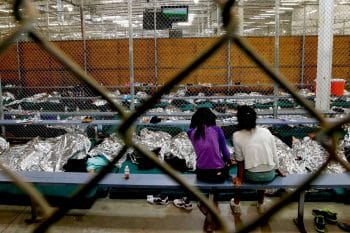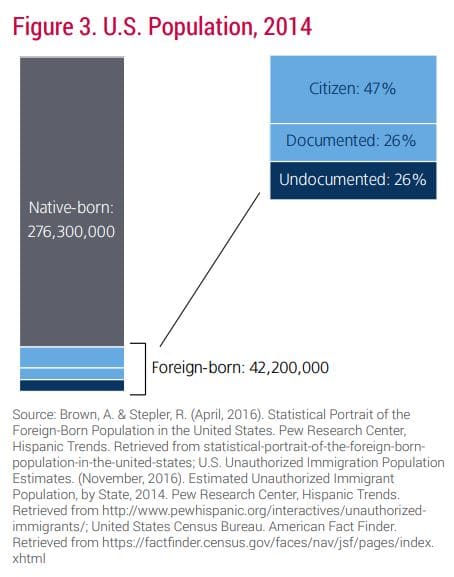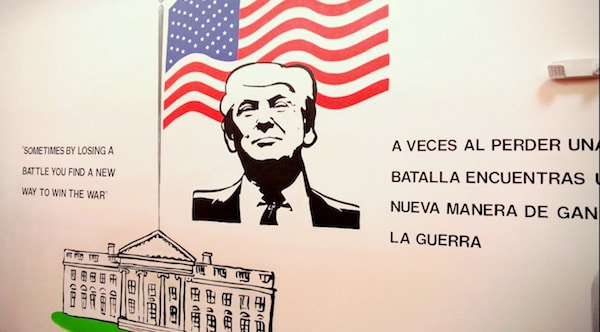While Donald Trump’s stepped-up repression of unauthorized migrants has been touted as a “get tough” policy meant to stem a flood of “animals” affiliated with transnational criminal groups, his draconian policies remain unlikely to deter desperate asylum-seekers from seeking entry to the United States. Instead, family separations and arbitrary prosecution and incarcerations are upping the scale of trauma suffered by refugees while asylum claims and border-crossings continue to increase.
Trump’s “Make America Great” policies may have resulted in misery for thousands of poor migrants, yet the rise in human suffering has resulted in jackpot prizes for some players at the New York Stock Exchange.
For Tomás A. Madrigal, a food systems researcher at Community to Community Development in Bellingham, Washington, these inhumane policies are all about dollars and cents.
“Under the Trump Administration, there are no ifs, ands, or buts – this is a class war,” Madrigal told MintPress News.
Just as White House policies on taxes, land-use, military expenditures and foreign trade have overwhelmingly favored the financial sector, the Trump-era immigration enforcement regime has directly translated into a huge boost in dividends for those invested in industries reliant on the exploitation of immigrants, and especially the commercial prison industry.
It’s the latest sequel in a franchise that began with the War on Drugs, continued with the War on Terror, and found renewed purpose with the rise of a new super-villain: the MS-13 “animals” from El Salvador, whose mantra – we’re told – is “kill, rape, control.”
The political economy of the U.S. immigrant enforcement regime shows how white nationalist or “nativist” populism, the criminalization of immigrants, the “swamp” of private interest lobbyists, the national security state, and neoliberalism – the corporate takeover of public services by monopolistic capital – have combined to fuel an expanding model of profit-driven trade based on mass punishment, mass confinement, and the exploitation of poor people.
“The tearing apart of families, we see as a terror tactic in a desperate attempt by the Trump administration to force down poverty wages for immigrants across multiple industries,” Madrigal said.
“Prison-Industrial Complex”: cliché buzzword or apt description?
While the term “prison-industrial complex” smacks of an activist catch-phrase or academic buzzword, the term is an accurate descriptor of the manner in which the growth of the U.S. prison population has multiplied, spawning lucrative public-private partnerships benefiting public officials and for-profit entities alike.
The prison-industrial complex is the natural byproduct of neoliberalism, which became the ruling doctrine of the West in the 1970s amid sharp crises in the capitalist world-system. Uninhibited capitalism or the “free market” was depicted as the purest form of liberty, resulting in monopoly enterprises and multinational corporations being given the freedom not only to stifle smaller companies but also to shatter unions, stifle workers’ wages, and destroy large swathes of the public sector.
By the late ‘70s, governments on the state and federal level coped with prison overcrowding caused by mass incarceration through legislation allowing private companies to contract with public prisons for the sake of cutting costs and tapping into incarcerated inmate labor.
As Cristoph Scherrer and Anil Shah noted in an article for The Bullet & Global Labour Forum published last April:
From there it was only a small step to propose using prisoners’ labor power as a source of income. The discourse on financing prisons and detainees moved from ‘public assistance’ to ‘self-financing’. Under neoliberalism, detention itself is becoming a self-inflicted penalty for which the prisoner and the prisoner’s relatives literally have to pay: processing charges for visits, rents for beds, and co-financing for medical care. In many cases, prisoners are released with bills for prison services of several thousand dollars.

Attorney General Loretta Lynch takes a tour of a factory during a visit to the Talladega Federal Correctional Institution in Talladega, Ala., Friday, April 29, 2016, to highlight policies that aim to reduce barriers for formerly incarcerated individuals. (AP Photo/Evan Vucci)
This has resulted, over the past decades, in the growth of a trend in profit accumulation where captive workforces face highly exploitative conditions where labor is deprived of the right to organize to better their conditions.
From Victoria’s Secret to Nintendo, Wisconsin cheese to Hawaiian papayas – as well as telecommunications and military industries – the prison economy has proven to be a boon to investors thanks to generous contracts from government and the extremely low cost of prison labor, which amounts to around $1 per hour for migrant detainees.
In the 2009 book The Prison-Industrial Complex & The Global Economy, authors Eve Goldberg and Linda Evans note:
For private business, prison labor is like a pot of gold. No strikes. No union organizing. No unemployment insurance or workers’ compensation to pay … New leviathan prisons are being built with thousands of eerie acres of factories inside the walls. … All at a fraction of the cost of ‘free labor’ … Even the 14th Amendment to the Constitution which abolished slavery, excludes prisoners from its protections.
As was the case under slavery, for-profit prisons thrive on the capture of masses of people and their exploitation within the walls of the prison industry. For those immigrants who speak up against their mistreatment or who demand basic rights, the punishment is severe.
Madrigal sees a direct parallel to trends in the agricultural industry, where growers are increasingly relying on guestworkers– unfree laborers, primarily from rural and indigenous parts of Mexico, whose residence in the U.S. relies on the good graces of employers who are in regular contact with the Department of Homeland Security. Given the instantly revocable nature of guestworker visas, workers are effectively prevented from organizing, creating a coercive labor regime that has been compared to slavery.
“Slaving is a lucrative business and … the legalization of slavery is happening before our very eyes under the Trump administration,” Madrigal said.
“It is a bifurcated system that special interest groups seek to streamline and automate, with the support of both major parties domestically,” he added, describing these policies as a form of “Trumpian capitalism.”
Immigrants for Sale
U.S. private prisons are largely controlled by a handful of monopolistic firms or real estate investment trusts, with GEO Group and CoreCivic (formerly Corrections Corporation of America, CCA) standing at the helm of the industry. For-profit prison operators threw their weight behind Trump’s “law and order” campaign in 2016. Following his election victory, both GEO and CoreCivic continued pouring cash into his till and each gave $250,000 toward the inauguration celebrations.
The two companies enjoyed contracts with the federal government to build and operate detention facilities under Obama, yet the companies’ stock took a sharp hit in 2016 after the outgoing administration announced plans to scale back government reliance on private prisons. Washington had been plagued with public pressure over abuses at private prisons and migrant detention centers, and headlines covering hunger strikes, suicides, sexual abuse and pitiful medical care filled newspapers on an alarmingly regular basis.

A holding area for mostly Central American immigrant children at the U.S. Customs and Border Protection Placement Center in Nogales, Ariz. July 17, 2014. Ross D. Franklin | AP
The private prison corporations’ investments in the Trump campaign were lucrative, to say the least. Upon coming to power, Trump swiftly followed through on his campaign promises to vastly boost ICE operations, with Attorney General Jeff Sessions’ Department of Justice quickly implementing a “zero-tolerance policy” requiring an increase in immigration and border agents along with a funding surge for detention facilities.
By late February, 2017 – scarcely a month after Trump’s inauguration ball – the prison companies’ stock prices rallied to previously unheard-of heights, nearly doubling in market value. Their profitability has continued to rise as market speculation and new influxes of taxpayer dollars, driven by overcrowding resulting from the exponential boost in migrant incarceration, fuels profits extracted from largely Latin American refugees fleeing conditions primarily created by U.S. imperialist policies in their home regions.
“The new regime is expanding quickly and utilizing all the tools left behind by the Obama administration,” immigrant rights activist and undocumented Bellingham-based community leader Maru Mora-Villalpando told MintPress News.
“They have made it easier for jails and now prisons to start detaining immigrants, plus [they are] looking at expanding or creating new private detentions centers for adults and children,” she added.
Watch | Private Prisons Back Trump
Janus-Faced Obama or the “Deporter-In-Chief”
During the mid-2010s, crime rates in the U.S. had dropped as social movements clamored for criminal justice reforms and the reduction of the racialized, disproportionate mass incarceration of primarily black and brown poor people. Increasingly, voters in states like California passed laws reducing sentences and reversing draconian laws like the “Three-Strikes” law. As a result, black communities have seen a modest decline in imprisonment rates.
However, the restive unauthorized migrant population – estimated to number anywhere between 11-12 million – had largely grown quiet in their demands for full rights following a period of intense political activity and mass mobilization in 2006 to resist the Sensenbrenner Bill, which sought to criminalize migrants and seek their wholesale removal.
This was a community that was on the receiving end of what Professor William I. Robinson called an “undeclared war” – and offshoot of the post-9/11 “war on terror” which, in the name of national security and anti-terrorism, sought to clamp down on migrant rights and install a militarized regime of immigrant detention and deportation.
Largely Latino and overwhelmingly Mexican and Central American, the immigrant community was also the most lucrative motor force for the U.S. economy, be it in agriculture, the hospitality industry, food service, childcare, domestic labor, retail, manufacturing, and so on.
As Robinson noted:
The super-exploitation of an immigrant workforce would not be possible if that workforce had the same rights as citizens, if it did not face the insecurities and vulnerabilities of being undocumented or ‘illegal.’ Granting full citizenship rights to the tens of millions of immigrants in the United States would undermine the division of the United States – and by extension, the global – working class into immigrants and citizens. That division is a central component of the new class relations of global capitalism, predicated on a “flexible” mass of workers who can be hired and fired at will, are de-unionized, and face precarious work conditions, job instability, a rollback of benefits and downward pressure on wages.
Watch | Immigrants For Sale
While Democrat politicians expressed sympathies for migrants with honeyed slogans like “No Human Being Is Illegal,” the Obama administration continued to fuel the ICE dragnet mass deportation apparatus. Contracts with private prison corporations were renewed while the administration issued forms of administrative relief like Deferred Action for Childhood Arrivals or DACA.
Amid these contradictions, the administration of Obama – whom many began to describe as the “Deporter-In-Chief” – remained somewhat open to popular pressure.
“The main difference is that the Obama administration had shame, the Trump administration has no shame,” Madrigal said, noting that his group had some degree of success “speaking truth to power” and preventing local law enforcement from enforcing immigration law.
In Madrigal’s opinion, the “rule of law” as overseen by Obama and then-Attorney General Eric Holder at least allowed advocates the space to successfully fight for gains. He added:
If you pay close attention, the Trump administration are replacing rule of law with what they desperately plead is the ‘moral authority’ of nationalism, white supremacy, and patriarchy. But their true moral authority is the death and premature death that they produce through war and incarceration.
Enter the white supremacist “nativists”
When Trump unleashed his campaign on the U.S. through loud promises to “Build the Wall” and keep Mexican “rapists” out of the country, it became clear that he was aiming to win the votes of white nativists, whose ideological aims coincided with the interests for-profit prison operators.
Indeed, Trump began to repeat dubious talking points from Breitbart that originated in the Washington, D.C. offices of anti-immigrant groups affiliated with the no-holds-barred white racialist far-right.
Such groups – NumbersUSA, the Federation for American Immigration Reform (FAIR), and think-tank offshoot the Center for Immigration Studies – were founded either directly or indirectly by white nationalist leader John Tanton.

Barbie Miller, left, yells as she joins demonstrators outside the Mexican Consulate, July 18, 2014, in Houston, Texas. David J. Phillip | AP
Since 1979, these groups – known as the Tanton network – began embedding themselves in the Republican Party through the use of savvy demagogic talking-points that radicalized discourse over immigration policy. The groups’ messaging simultaneously played on white American insecurities over falling standards of living and unemployment resulting from neoliberal policies, as well as dog-whistles that played on the time-honored U.S. tradition of scapegoating communities of color and recently-arrived immigrants from the Global South.
In 1993, the population control-obsessed Tanton argued that a “European-American majority” was needed “for European-American society and culture to persist.” In his essay “Alien Invasion,” Tanton further described migrants as a parasitic, amoeba-like entity “that reproduces rapidly and eats everything in sight.” By 1997, Tanton said that the urgent closure of the border was needed to prevent immigrants “defecating and creating garbage and looking for jobs.”
Without using old-school racist slurs – at least not publicly – Tanton was clearly positioning non-European “aliens” as a threat to Judeo-Christian civilization and white “natives” in the U.S. Tanton and his network of groups like FAIR issued constant bulletins and studies reinforcing his lurid, dehumanizing depictions of feces-flinging migrants laying waste to the U.S., a precursor to Trump’s description of “American Carnage,” where Central American MS-13 hoodlums and their non-criminal relatives or “animals” run rampant in the U.S.
By 2016, Tanton network white nationalists had metastasized across the G.O.P. and were especially well-represented in the Trump campaign. Officials like then-Senator and now-Attorney General Jeff Sessions and his close comrade Stephen Miller were among the most prominent FAIR affiliates in Trump’s team.
Sessions had successfully led fights against modest immigration reform attempts under the Bush and Obama administrations and was a fierce proponent of integrating the federal immigration enforcement apparatus with state and local law enforcement agencies. He also demanded an end to the “catch and release” policy of President Obama, which allowed unauthorized migrants apprehended by ICE to reside in the U.S. free of incarceration until they could have their day in immigration court.
Upon coming to power, Trump and Sessions unleashed the floodgates of the Tanton network upon his cabinet while undoing Obama administration controls on ICE. Formerly considered the lunatic – perhaps neo-fascist – fringe of the conservative movement, these white nationalists instead grew to dominate policy discussions inside the Republican Party and their implementation by the executive branch.
As recently as last month, Trump tapped Ronald Mortensen – a notorious anti-immigrant extremist and fellow from the Center for Immigration Studies – to head the State Department’s Bureau of Population, Refugees and Migration. Prior to being picked, Mortensen had accused undocumented migrants of “serious felonies that impact American men, women and children.”
 Mortensen also claimed that “even the strongest supporters of illegal aliens acknowledge that 75 percent of illegal aliens routinely commit felonies” – a completely fabricated figure that flies in the face of reputable studies showing that undocumented immigrants commit crimes at lower rates than U.S. citizens.
Mortensen also claimed that “even the strongest supporters of illegal aliens acknowledge that 75 percent of illegal aliens routinely commit felonies” – a completely fabricated figure that flies in the face of reputable studies showing that undocumented immigrants commit crimes at lower rates than U.S. citizens.
Under Sessions and his Tanton-affiliated colleagues, the Justice Department and Department of Homeland Security have vastly expanded the mandate of federal immigration agents to clamp down on dissent, as Mora-Villalpando found out in May when she received a deportation order after a Washington Department of Licensing employee sent her information to ICE. The targeting of Mora-Villalpando caused a huge national uproar that ultimately resulted in the resignation of the department’s head.
Mora-Villalpando told MintPress News:
DOJ’s role is critical is criminalizing our immigrant communities and making it easier for ICE to detain and excuse deportations. It’s a clear attack on anyone that is an immigrant with or without papers, anyone having to flee and migrate, and anyone that dare speak against these practices.
The new policies have also chilled popular dissent in immigrant communities, yet Mora-Villalpando stresses that the resistance won’t end.
“While many are more scared than before, there are some that will continue speaking up and organizing,” she said.
“There is hope as long as we continue fighting”
Continuing, Mora-Villalpando observed that not only Trump officials but the rank-and-file of ICE and the DHS Customs and Border Protection agency are of like mind with the present administration, and can be expected to use their powers for the purpose of stifling immigrant rights advocate.
She commented:
ICE has become a full political repression machine, and it wasn’t that difficult since they are already an agency intended to destroy our communities. They, along with CBP, jumped on the political anti-immigrant racist xenophobic wagon since the electoral year in 2016 by endorsing trump during his campaign.
“What they didn’t expect after they started targeting us for our political work was that the community would fight back,” she added.
Mora-Villalpando doesn’t think that minor reforms or protections such as DACA or a bipartisan comprehensive immigration reform can come close to ending the increasing use of private prisons or suffering her community has undergone following the targeting of immigrants following September 11, 2001.
For that very reason, she and like-minded organizers aren’t soft-stepping around the issue but are aiming at the heart of state terror and the campaign of mass confinement aimed at millions of undocumented U.S. residents.
When asked about her demands, Mora-Villalpando cuts to the chase:
The demand is simple: abolish ICE.
By doing so, the entire machine will fall apart – the private sector that benefits off criminalization [and] even the non-profits that also live off immigrants’ misery.
The agency has only been around for 15 years. It’s time for them to be gone and all the millions and millions of dollars that have been used to exploit and oppress our communities should be invested in education, housing, and healthcare.
Mora-Villalpando doesn’t see the demand as unrealistic, nor does she see the Trump administration as capable of stifling migrant communities’ aspiration for dignified and just treatment rather than an open-ended war against them.
There is hope, as long as we continue fighting. Regardless of the retaliation and intimidation tactics [the government] uses against us, we won’t give up.


